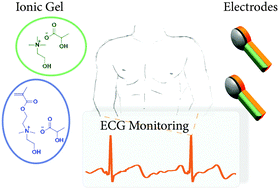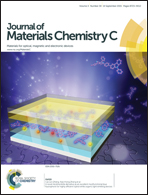Cholinium-based ion gels as solid electrolytes for long-term cutaneous electrophysiology†
Abstract
Cholinium-based bio-ion gels were prepared by photopolymerization of poly(cholinium lactate methacrylate) network within cholinium lactate ionic liquid. The rheological and thermal properties as well as ionic conductivity of ion gels of different compositions were measured. As indicated by rheological measurements, the ion gels show the properties of gel materials which become soft by increasing the amount of free ionic liquid. Cholinium ion gels with various composition of free ionic liquid vs. methacrylic network show glass transitions between −40° and −70 °C and thermal stability up to 200 °C. The ionic conductivity of these gels increases from 10−8 to 10−3 S cm−1 at 20 °C by varying the amount of free ionic liquid between 0 and 60 wt%, respectively. Low glass transition temperature and enhanced ionic conductivity make the cholinium-based ion gels good candidates to be used as a solid electrolytic interface between the skin and an electrode. The ion gels decrease the impedance with the human skin to levels that are similar to commercial Ag/AgCl electrodes. Accurate physiologic signals such as electrocardiography (ECG) were recorded with ion gels assisted electrodes for a long period of time (up to 72 h) with a remarkable stability. The low toxicity and superior ambient stability of cholinium ionic liquids and ion gels make these materials highly attractive for long-term cutaneous electrophysiology and other biomedical applications.


 Please wait while we load your content...
Please wait while we load your content...